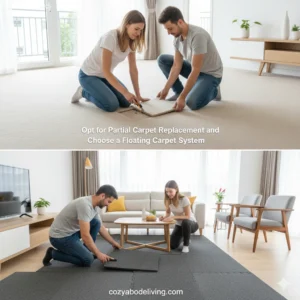Replacing carpet doesn’t have to be stressful or require clearing an entire room. Many homeowners avoid updating their flooring because they worry about lifting heavy sofas, beds, or wardrobes. But with the right approach, you can refresh your rugs & carpet without removing furniture at all. The key is using smart installation techniques, modern flooring options, and simple tools that make the process smooth and manageable.

Table of Contents
Toggle1. Replace Carpet in Sections to Avoid Heavy Lifting
Sectional carpet replacement is the easiest technique when furniture can’t be moved out. This method involves dividing the room into smaller zones. You shift the furniture slightly within each zone, replace the carpet underneath, and continue until the whole room is complete.
Why it works:
-
Keeps the room functional
-
Reduces strain on furniture and flooring
-
Prevents damage to walls or décor
This method is especially helpful in crowded bedrooms, home offices, and compact living rooms.
2. Install Carpet Tiles for Hassle-Free Flooring
Carpet tiles are one of the best innovations for modern flooring. They can be placed individually, making them perfect for furnished rooms. You can lift one piece at a time, slide it under furniture legs, and continue the layout without major movement.
Benefits of carpet tiles:
-
Easy to install and replace
-
No stretching or tacking required
-
Wide variety of colors and textures
-
Fits well with current rugs & carpet styling trends
They’re ideal for renters or homeowners who want flexibility and a quick makeover.
3. Use Furniture Sliders to Shift Items Just Enough
Heavy furniture often makes carpet replacement difficult, but you don’t need to lift it completely. Furniture sliders or thick cardboard pieces can help you gently shift furniture an inch or two—just enough to tuck the new carpet underneath.
This technique works for:
-
Couches
-
Beds
-
Cabinets
-
Coffee tables
-
Bookshelves
It’s a safe, practical trick that protects both your furniture and flooring.
4. Layer an Area Rug Instead of Full Replacement
If your old carpet is only worn in certain areas, a stylish area rug may be a simpler solution. Layering rugs is a popular home décor trend because it adds warmth, texture, and visual depth.
Why choose rug layering?
-
Covers high-wear zones
-
Adds instant décor enhancement
-
Requires no installation
-
Affordable alternative to full carpet replacement
This solution blends perfectly with any interior theme and instantly upgrades your space.
5. Choose a Floating Carpet System
Floating carpets come with built-in padding and do not require glue or tack strips. They can be trimmed to fit around furniture, making them perfect for busy rooms.
Advantages:
-
Quick installation
-
No adhesives
-
Easy to replace later
-
Works well with existing furniture layout
This is a great long-term option if you want a clean finish with minimal disruption.
6. Opt for Partial Carpet Replacement
If only certain sections are damaged—such as near doorways or high-traffic spots—you can replace just those areas. A professional can blend the new carpet with the existing one, making it look cohesive.

7. Hire Professionals Who Specialize in No-Move Carpet Replacement
Many carpet technicians use special tools like carpet lifters, sliders, and rollers designed for furnished rooms. They complete the installation quickly and efficiently without requiring full furniture removal.
FAQs
1. Can carpet be replaced without removing furniture?
Yes, sectional replacement and carpet tiles make it possible to install new carpet without clearing the room.
2. What type of carpet is easiest to install with furniture inside?
Carpet tiles are the easiest because they can slip under furniture and require no stretching.
3. Is layering rugs a good alternative to replacement?
Yes, layering a large area rug can cover worn spots and enhance your décor instantly.
4. How do professionals replace carpet in furnished rooms?
They use sliders, lifting tools, and sectional techniques to avoid heavy furniture removal.
5. Will partial carpet replacement look uneven?
When done professionally, the transition is smooth and barely noticeable.
